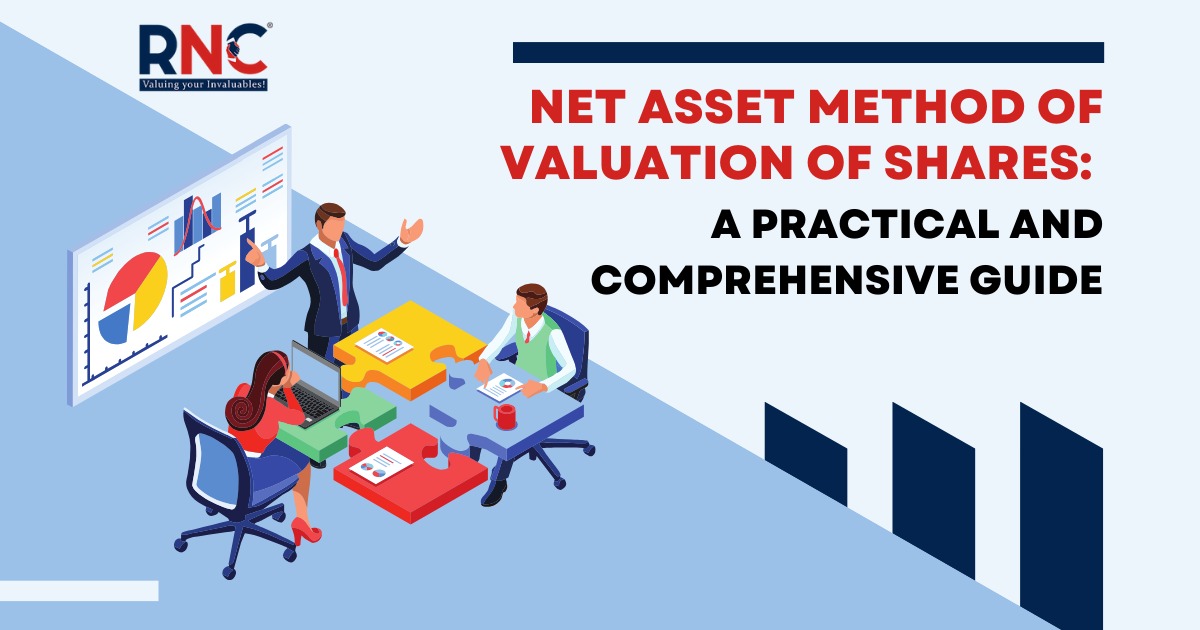
Valuation of share is a fundamental concept in corporate finance, helping determine the true worth of a company’s equity. Whether you’re preparing for mergers, taxation, investment decisions, or regulatory compliance, understanding how to calculate the value of shares is critical—especially in 2025 when precision and transparency are more important than ever.
Valuation of shares is a critical exercise for investors, promoters, auditors, and regulators. Among the different approaches, the Net Asset Method (NAM) remains one of the most reliable methods for valuing shares, especially for asset-heavy businesses.
In 2025, the Net Asset Method has gained renewed importance as regulatory bodies emphasize transparency, and investors seek clarity on intrinsic value. This updated guide explains the concept in detail, walks through step-by-step calculations, and shares real-world examples to help you understand how shares are valued using NAM in today’s financial landscape.
The valuation of share is a critical step for investors, business owners, and financial analysts to determine the fair worth of a company’s equity. Among the various methods, the Net Asset Method remains one of the most reliable, especially for asset-heavy businesses and liquidation scenarios. This approach calculates the valuation of share by assessing the company’s total assets, deducting liabilities, and dividing the net value by the number of outstanding shares. In this guide, we’ll walk you through the concept, provide a worked example, and explain how professional valuation services can ensure accuracy and compliance.
Among the various methods available, the Net Asset Method is one of the most reliable approaches to share valuation, particularly for asset-heavy businesses. This expert-backed guide explains how the Net Asset Method works, when to use it, key formulas, and real-world examples to help you apply it correctly.
Whether you’re a financial analyst, business Valuation , or valuation professional, this blog will walk you through the process step by step—equipping you with both the technical understanding and practical knowledge needed for accurate, compliant share valuation.
Need a Professional Valuation?
Get an accurate valuation for your assets or business within 24 hours.
Book a Consultation
Why Accurate Share Valuation Matters?
Determining the true value of a company’s shares is crucial for investors, business owners, and stakeholders alike. Accurate share valuation methods empower informed decision-making, whether it’s for mergers, acquisitions, investments, or even strategic business planning. A miscalculated valuation can lead to financial loss and missed growth opportunities.
What is the Net Asset Method of Valuation of Shares?
The Net Asset Method of valuation of shares is an asset-based valuation technique that calculates a company’s worth by evaluating its total assets minus its total liabilities. Particularly suitable for asset-intensive businesses, this method provides clarity by focusing on tangible and quantifiable elements. It’s highly valuable when other methods, such as earnings-based approaches, might not reflect the true financial health of a company.
Read Also: Valuation of Shares Problems: Solutions for Investors
Step-by-Step Guide to NAV Calculation
Understanding how to accurately calculate the Net Asset Value (NAV) is crucial for performing precise asset-based valuation. The NAV calculation method involves systematically identifying, adjusting, and calculating the net value of a company’s assets. Here’s a clear, step-by-step guide:
Step 1: Identify and List All Assets and Liabilities
Begin by compiling a comprehensive list of the company’s assets and liabilities from the balance sheet. Include tangible assets like machinery, real estate, inventory, and cash, as well as intangible assets such as intellectual property, if applicable. Clearly document liabilities, such as loans, debts, and obligations.
Step 2: Adjust the Value of Assets and Liabilities (Adjusted Net Asset Method)
Next, perform necessary adjustments to reflect the accurate current market value rather than historical or book value. Common adjustments under the Adjusted Net Asset Method include:
- Updating the market valuation of real estate or equipment.
- Revaluing inventory based on realizable value.
- Adjusting accounts receivable to reflect collectible amounts.
Step 3: Calculate the Final NAV (Asset-Based Valuation)
After adjustments, the final step is calculating the NAV using the formula:
Net Asset Value (NAV) = Total Adjusted Assets – Total Adjusted Liabilities
This resulting figure represents the intrinsic value of the company’s equity based on its assets and liabilities. Clearly presenting this NAV calculation provides transparency and confidence in your valuation outcomes, particularly useful in transactions, mergers, or acquisitions involving asset-intensive companies.
When to Use the Net Asset Method in 2025
The Net Asset Method is not suitable for every company—but in specific scenarios, it’s the most logical and accepted approach.
1. Valuing Investment Holding Companies
These companies typically generate little or no operational income, but own significant shareholdings or physical assets. NAM accurately captures the intrinsic value of such holdings.
2. Startups and Private Companies with Asset-Heavy Structures
Early-stage or bootstrapped companies may not have revenue or profits, but hold valuable intellectual property, real estate, or equipment. NAM helps determine a fair valuation of shares in such cases.
3. Transfer Pricing & Tax Compliance
In 2025, Indian tax laws (including Rule 11UA of the Income Tax Rules) continue to accept NAM for share valuation during share transfers, capital restructuring, and under FEMA regulations.
4. Insolvency or Liquidation Scenarios
During IBC proceedings or liquidation, asset-based valuation becomes critical. NAM helps stakeholders assess realizable value for distressed entities.
Common Mistakes to Avoid in NAV Valuations
- Ignoring asset market value: Using outdated book values instead of current market values.
- Overlooking intangible assets: Underestimating or completely missing intangible assets like IP, patents, or trademarks.
- Improper liability adjustments: Not adjusting liabilities to reflect true market obligations.
- Excluding contingent liabilities: Omitting liabilities that may arise in the future, leading to inaccurate valuation.
- Inconsistent accounting standards: Mixing accounting standards or methodologies, resulting in valuation errors.
To ensure accuracy and reliability, it’s advisable to regularly update asset and liability valuations to reflect market conditions, meticulously account for intangible and contingent assets or liabilities, and consistently apply recognized accounting standards. Engaging experienced valuation services significantly reduces risks of error. Expert valuation firms bring industry-specific insights, ensuring valuations are precise, compliant with regulations, and capable of standing up to rigorous financial scrutiny.
Net Asset Method in Practice: Sample Case Study (2025)
Let’s walk through a practical example to see how the Net Asset Method (NAV) is applied for valuing shares in a company.
Starting Balance Sheet Data (as of March 2025)
| Particulars | Amount (₹ Lakhs) |
|---|---|
| Fixed Assets (Net) | 500 |
| Investments | 100 |
| Current Assets | 300 |
| Cash & Bank Balances | 100 |
| Total Assets | 1,000 |
| Secured Loans | 200 |
| Unsecured Loans | 50 |
| Creditors & Other Liabilities | 150 |
| Total Liabilities | 400 |
| Equity Share Capital | 300 |
| Reserves & Surplus | 300 |
| Total Equity | 600 |
Adjustments Made
-
Revaluation of Fixed Assets: Market value is ₹600 lakhs (up from ₹500 lakhs)
-
Non-operating Assets: Remove non-business investments: -₹30 lakhs
-
Provision for doubtful debts: ₹10 lakhs deducted from Current Assets
Revised Net Asset Value Calculation
-
Adjusted Fixed Assets: ₹600 lakhs
-
Investments (after removing non-business): ₹70 lakhs
-
Current Assets (after provision): ₹290 lakhs
-
Cash & Bank: ₹100 lakhs
-
Total Adjusted Assets: ₹1,060 lakhs
-
Liabilities (unchanged): ₹400 lakhs
-
Net Assets Available to Shareholders: ₹1,060 lakhs – ₹400 lakhs = ₹660 lakhs
Final NAV and Share Value
If there are 3 lakh equity shares,
NAV per share = ₹660 lakhs / 3 lakhs = ₹220 per share
This example shows how market-based adjustments to the balance sheet can lead to a more realistic and updated valuation of shares using the Net Asset Method.
Net Asset Method vs. Other Popular Valuation Methods
Choosing the right valuation method significantly impacts strategic financial decisions. Here’s a brief comparison of the Net Asset Method (NAV) with two other popular valuation techniques—Discounted Cash Flow (DCF) and Earnings Multiple methods:
| Valuation Method | Basis of Valuation | Ideal Scenario | Limitations |
| Net Asset Method (NAV) | Assets minus liabilities | Asset-intensive companies, liquidation scenarios, tangible asset-heavy industries | Less effective for businesses with high intangible assets |
| Discounted Cash Flow (DCF) | Present value of future cash flows | Stable, predictable cash flows; growth-oriented businesses | Highly sensitive to assumptions and forecasts |
| Earnings Multiple Method | Company earnings multiplied by industry-specific factors | Businesses with stable, consistent earnings; mature companies | Depends heavily on accurate industry multiples and market conditions |
The Net Asset Method is particularly suitable when assessing asset-intensive business valuation , such as manufacturing, infrastructure, or real estate companies. It provides clarity in cases of liquidation, mergers, acquisitions, or where the company’s value is predominantly in physical assets rather than future earnings potential.
Professional valuation firms play a pivotal role in guiding businesses toward the most suitable valuation method. Leveraging their expertise, valuation specialists thoroughly assess business structures, asset types, and financial objectives, helping businesses select the valuation technique that provides the most accurate and reliable outcomes.
Read Also: Valuation of Shares Problems: Solutions for Investors
Conclusion
The Net Asset Method of share valuation provides a clear, asset-backed picture of a company’s true worth. While it may not capture intangible value, it remains a practical and widely accepted approach for industries with significant fixed assets. In 2025, as investors and regulators demand greater transparency, NAM continues to play a vital role in audits, transactions, and compliance.
Looking for expert help with share valuation under NAM or other methods?
At RNC Valuecon LLP, our professionals deliver accurate, compliant, and investor-ready valuation reports trusted by corporates, regulators, and auditors.
📅 Book a Consultation today and get clarity on the real worth of your shares.
FAQs
1. What is the Net Asset Method of share valuation?
It calculates value per share by adjusting assets to fair market value, deducting liabilities, and dividing by total shares.
2. When is the Net Asset Method most useful?
It is best for asset-heavy companies, SMEs, liquidation scenarios, or regulatory compliance under FEMA/Companies Act.
3. What are the drawbacks of the Net Asset Method?
It ignores future profitability and market sentiment, making it less suitable for startups or growth companies.

About the author:
Sahil Narula
Sahil Narula is the Managing Partner at RNC Valuecon LLP and a Registered Valuer with IBBI. He brings over a decade of experience in Valuation Services, Corporate Finance, and Advisory, having led numerous complex assignments under the Insolvency & Bankruptcy Code, 2016, Mergers & Acquisitions, Insurance, and Financial Reporting.
He is a regular speaker at national forums (ASSOCHAM, CII, ICAI, IBBI, Legal Era) and currently serves as Co-Chairman of ASSOCHAM’s National Council on Insolvency & Valuations and a member of CII’s Task Force on Insolvency & Bankruptcy.
🤝Connect with Sahil on LinkedIn.
